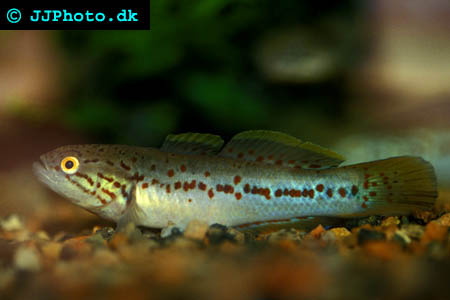Mogurnda mogurnda (Australian Spotted Gudgeon)
Mogurnda mogurnda is a small fish found in northern Australia and in New Guinea. It is known under several different common names in English, including Australian Spotted Gudgeon, Northern Purple Spotted Gudgeon, Northern Trout Gudgeon, and Chequered Gudgeon.
Mogurnda
All members of the genus Mogurnda are small substrate dwelling gobies that can survive in environments that few other marine fish species can cope with, such as waters where both salinity and oxygen levels are really low. In their native environment, they have been found in fast flowing streams as well as boreholes and ponds. They are bold and remarkable resourceful when it comes to conquering water obstacles.
Habitat and range
Mogurnda mogurnda is the only member of its genus that can be found in both Australia and New Guinea. The species inhabit a wide range of habitats and has proven remarkably flexible when it comes to feeding. Its Australian range includes the northwestern parts of the continent across Kimberley and Arnhem Land to the Gulf of Carpentaria drainage, Cape York and eastwards towards the Mossman River. In New Guinea, you will find these fishes in the lower Kikori River system westward to Etna Bay in the Irian Jaya province.
Housing
Wild Australian Spotted Gudgeons can grow up to 17 cm in length, but they will normally remain smaller in captivity. An aquarium measuring at least 60x40x40cm is recommended. The aquarium should be well decorated and include a lot of hiding spots; you can for instance use live plants, rocks and ceramic flower pots. When frightened, Australian Spotted Gudgeons will instinctively jump to get away from aquatic predators and using a secure lid is therefore recommended to avoid having to scope them up from your carpet. The water temperature should be around 25 degrees C and the pH-value neutral or alkaline (keep it in the pH 7.0-8.0 range). Australian Spotted Gudgeons are known to be fin nippers and any tank mates must therefore be carefully selected.
Feeding
As mentioned earlier, Mogurnda mogurnda is extremely flexible when it comes to food. In the aquarium, it will happily gulp down virtually anything you give it. Keep it on a varied diet that contains plant matter as well as meaty foods. A high-quality flake food for omnivores or pellets will form a great base.
Breeding Spotted Gudgeon – Mogurnda mogurnda
In the wild, Mogurnda mogurnda will form pairs and spawn during the rainy season. Mimicking a dry season and a subsequent wet season is therefore a good idea if you want to induce breeding. Since these fishes hail form the southern hemisphere, they are used a rainy season that falls between late October and early March, but they can breed during other parts of the year as well when kept in aquariums. During the rainy season, a female Mogurnda mogurnda can produce eggs for up to 10 spawnings.
If you want to breed Mogurnda mogurnda, it is recommended to feed them plenty of protein rich foods to get them into breeding condition. You can for instance use bloodworms and high protein pellets. You know that they are getting ready to breed when the male becomes more blue than normal and sports a very pointed urinogenital area. The female will also start to swell up from the eggs inside her.
Mogurnda mogurnd
Copyright www.jjphoto.dk
During spawning, the female will chose a suitable spot to lay her demersal adhesive eggs. In aquariums, Mogurnda mogurnda females frequently use the glass sides of the aquarium. The eggs are laid in clusters measuring up to 5 cm in diameter and will stick to the spawning site by means of tiny threads. If you watch closely, you can see the eggs waft in the current. During spawning, the male will swim right behind the female and promptly fertilize the eggs as they are laid. He will then start fanning the eggs with fresh water and guarding them from all potential attackers. He will even chase away his mate to safeguard the offspring.
The number of eggs depends on the age and size of the female. If you have a small, young female that has never spawned before, do not expect more than 20 eggs. As she grows older and bigger, you can expect 100-200 eggs per spawning.
It can take up to 10 days for the eggs to hatch, but in warm aquariums the time can be decreased down to no more than 5 days. As the fry emerge, the male will stop guarding the offspring and you need to remove any adult fish, including the parents, from the aquarium. Another way of protecting the fry is to catch them and move them to a separate fry rearing aquarium. If you find it difficult to catch fry, you can opt for a third method: gathering the eggs and moving the
